31 Days, 31 Lists: 2022 Informational Fiction

Near the end of each year I have some time to try to catch up on my adult reading. Right now I’m very much enjoying Gabrielle Zevin’s Tomorrow and Tomorrow and Tomorrow. At one point our main character reflects that some of the people in her life (and I’m paraphrasing here) “… had little tolerance for the inevitable gray areas of life.”
What could be a grayer area than informational fiction? Precariously perched between fact and fiction, it ascribes itself to neither world. I didn’t even have a proper term for this before Melissa Sweet handed me the correct terminology. Now I know. “Informational Fiction” a.k.a. fiction with facts worked in or factual info with a healthy dollop of fiction.
ADVERTISEMENT
ADVERTISEMENT
Today we celebrate these chimeras. Would that I could make them a section entirely of their own in a library. Until that happy day arrives, enjoy flummoxing your catalogers with them! They’re strange hybrid beasts, but boy do I enjoy them!
Curious about other books that mix their fact and fiction together? Then check out some previous years’ lists:
2022 Informational Fiction
The Blanket Where Violet Sits by Allan Wolf, ill. Lauren Tobia

Sometimes I have a little internal debate over where precisely to categorize one picture book or another. Should, for example, the book The Blanket Where Violet Sits go onto the Informational Fiction list since it provides a nice encapsulation of our place in the wider universe, or should I put it on the Rhyme list since it’s built atop that old “This Is the House That Jack Built” (a.k.a. cumulative) formula? Why not both? Any book illustrated by Lauren Tobia gets this immediate leg up in the world anyway, but what’s nice about this title is how cozy it all is. It can feel intimidating to look into the sky and understand just how very small you are in the grand scheme of things. Wolf and Tobia conspire here to both acknowledge that point and counter it with the comfort of having your family around you. It’s also neat to see a cold weather nighttime picnic in a book (something I don’t recall seeing before). Great for science storytimes or just general STEM rhyming in general.
Building by Henry Cole
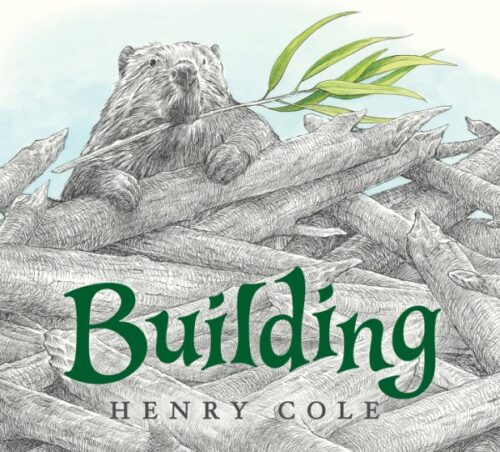
What other animal alters habitats to suit its needs? A beautifully rendered look at everyday beaver life as they build the structures that help the ecosystems around them. You know who’s cool? Henry Cole. You know what Henry Cole drew this year? Beavers. Awesome. Wonderful. Beavers. I’m a huge beaver fan and already 2022 is turning out to be a marvelous beaver year. Later in this post you’ll get to see the book The Lodge that Beaver Built by Randy Sonenshine. In any case, this is not technically nonfiction since there’s a bit of a story, but the facts are down pat. No backmatter either, but who cares? Beavers are awesome and that’s why I invented this category in the first place. Deserves more reads.
Eat Your Peas, Julius! Even Caesar Must Clean His Plate by Shirin Yim Bridges, ill. Fiona Lee
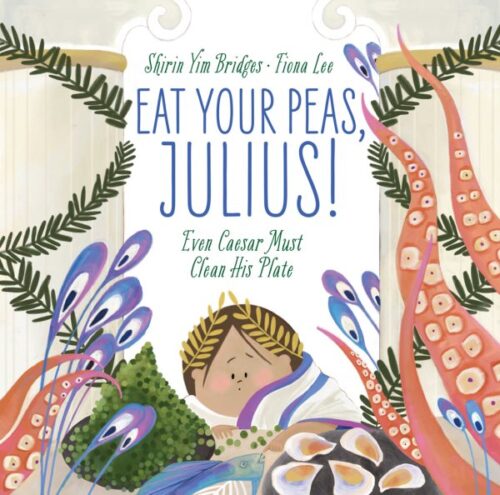
This one’s quite a bit of fun. A glance at the title and I figured it would be some Emily Post-esque storyline with a Roman twist. Not a bit of it! What we have here are the oddities of the Romans on full display, roasted peacocks and all! Do you have picky eaters in your home? Then you absolutely must show this to them. Essentially, the book is a set of instructions that a child Julius Caesar would have had to follow if his parents were hosting a fancy dinner party. There are the men, reclining on couches at the table. There’s the rose water for washing the feet. And, of course, the food. Stuffed sow’s udders, boiled camel feet, and an extra special treat: a little baked dormouse. All this would be delightful in and of itself but the backmatter includes additional information (my favorite: “Baked dormouse was a particular Roman favorite, so much so that special dormouse-fattening jars were invented.” I’d have appreciated a tiny bibliography in there somewhere so that we know where Bridges is getting her information, but since I’m placing this in the “Informational Fiction” section we can afford to be a little lenient. Another title to convince us that maybe the past wasn’t all it’s cracked up to be. Foodwise, anyway.
How to Bake a Universe by Alec Carvlin, ill. Brian Biggs

Wanna make a universe? It’s easy! All you need is a heaping pile of nothing, an oven that goes to Absolute Hot, and an understanding of the possibility of multi-verses. A deliciously fun breakdown of a complicated idea. You all know me, so you know that I get 20 different kinds of squidgey when folks start mixing their fiction and their nonfiction together. But doggone it, if you’re going to explain the very beginnings of existence itself, it’s nice to couch it in a fun cooking metaphor. Now I already was deep in the pocket of my Brian Biggs fandom, but I wasn’t sure about this Alec Carvlin fellow. Turns out, he knows what he’s doing. I am not ashamed to admit that I always thought the Big Bang was . . . y’know . . . a big old bang. Not so much. This book clarifies that and oh my, that backmatter! I just want to take that Timeline and frame it on my wall. No lie.
I Love Strawberries! by Shannon Anderson, ill. Jaclyn Sinquett

I kill strawberries. Literally, the plants die mere moments after being put in the ground in my yard. And if my black thumb doesn’t destroy them, my hungry squirrels will (who knew squirrels were such big time strawberry fans?). So maybe I was just perfectly primed for this story of a girl who gets to fully indulge in the ultimate strawberry growing fantasy. The idea of not only growing an abundance of strawberries but an OVERabundance is so tempting. The strawberry facts peppered on the pages are marvelously rendered. Even if you have a kid who professes to not like strawberries, this book may convince them otherwise. Delicious, sweet, and the strawberries aren’t half bad either!
Letters to Ammi by Aftab Yusuf Shaikh, photographs by Adrija Ghosh and Soumitra Ranade

There are loads and loads of picture books out there that take place in famous cities. Famous, I should say, American and European cities. Cities in pretty much any other part of the world have a tendency to get forgotten. This book is a beautiful look at Delhi, and it’s coupled with a story that slowly unfolds itself as it proceeds. A girl is writing letters to her mother. Her mother used to live in Delhi, so the girl goes from place to place recounting not just her own experiences but the memories other people have of her mom in those places. You see everything from Jama Masjid, the largest mosque in India, to the Qutub Minar, the tallest brick minaret in the world, the market of Chandni Chowk, and more. The book is also illustrated with photographs of each of these areas, with illustrations sometimes continuing where the photos stop. It’s an epistolary picture book, but one where the mother will never write back, a fact you discover at the end when the girl visits her mother’s grave. A more serious travelogue than we usually see in the children’s room, and a necessary one.
The Lodge that Beaver Built by Randy Sonenshine, ill. Anne Hunter
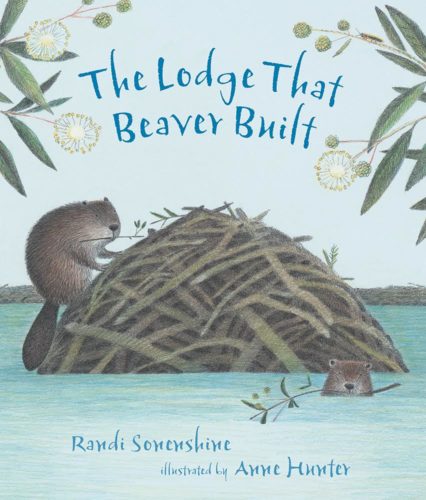
Beaver book #2! “This is the crunch in the darkening wood / of teeth against bark where the willow once stood.” Gentle rhymes and accurate facts tell the tale of one beaver family building homes near and far. I mean, I love beavers. Straight up love them, so I am not the most ideal person to judge this book. Once you’ve read the Superpowered Field Guide to Beavers by Rachel Poliquin, you come away thinking that you’re an expert. Even so, I was grateful that this book included information that I haven’t heard before (muskrats sometimes pop up in beaver lodges in the winter?). The gentle rhyming structure scans and informs at the same time. And there’s a nice section at the end of beaver facts, that I liked a lot. Makes me want to take an early morning walk over to Northwestern to see if my beavers are still there!
Loujain Dreams of Sunflowers: A Story Inspired by Loujain AlHathloul by Lina AlHathloul and Uma Mishra-Newbery, ill. Rebecca Green
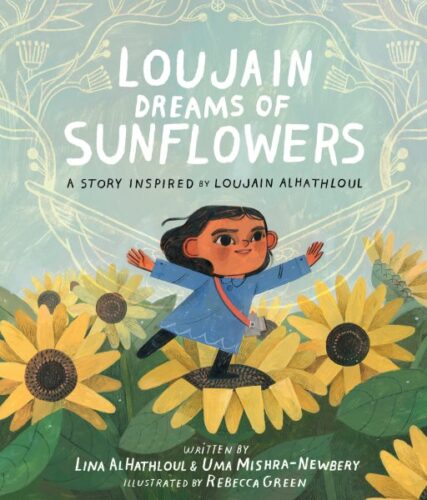
I kind of wish I’d read this book cold rather than notice the mention of Loujain AlHathloul in the subtitle. If you just take it at face value it’s doing something mildly impossible. I cannot stress enough how it is really really REALLY difficult to write a good picture book about phallocentric patriarchies. The old “girls can do anything” mantra loses a little of its oomph every time it appears in a mediocre book. Yet we desperately need such stories since the situations that inspire them still exist. What Lina and Uma have done here is turn Lina’s sister, Loujain’s, life into a bit of a metaphor. It’s about a girl who wants to fly and has wings, but is forbidden from flying because it’s not what girls are supposed to do. Now this endeavor is helped mightily by the art of Rebecca Green (who, to my mind, isn’t being given enough jobs these days). As far as I can tell, the whole reason it works is that it’s just a little bit weird. The Loujain of this story wants to fly to a place that’s filled with sunflowers (and apparently is loaded down with hidden cameras). In the back you get a note about the real Loujain in Saudi Arabia, and how this is a book about her insistence that women be allowed to drive. I think this book ultimately works because it doesn’t get so wrapped up in its own messaging that it forgets to make a good story along the way. Also, when was the last time you read a children’s book about women prosecuted for driving in other countries? Odd and wonderful.
Love in the Library by Maggie Tokuda-Hall, ill. Yas Imamura

ADVERTISEMENT
ADVERTISEMENT
It has gotten to the point where one sometimes feels like 90% of the children’s books written about the Japanese internment camps must talk about baseball in some way. And I understand this instinct. Faced with such hopeless historical information, baseball provides a glint of hope. It’s built into the very structure of the game itself. However, there are other ways of gleaning hope. The book Dear Miss Breed, for example, looked at the letters kids sent from the camps to a librarian on the outside. Tokuda-Hall has gone a different route and written a romance picture book. This is interesting to me since oftentimes romance in picture books tends to be fantastical or starring animals. This book (which was perfectly timed earlier this year for Valentine’s Day displays) fictionalizes her grandparents’ meeting in the Minidoka camp. Imamura’s art is also particularly keen. Note the use of red on the cover and how she incorporates it into the interior art. A slight, spare, beautifully told ode to her grandparents while also presenting eye-opening historical information for kids.
Our Story Starts in Africa by Patrice Lawrence, ill. Jeanetta Gonzales

I mean, any book that includes Atinuke’s Africa, Amazing Africa: Country by Country from 2021 in its Bibliography at the back is instantly going to have my respect. With its fictionalized framing sequence, Lawrence has put together a picture book that feels like it should have been written already, and yet nothing had until now. Young Paloma is visiting her family in Trinidad, but while she is there her cousins make fun of the way that she talks. Hanging out with her Tante Janet, she starts to hear stories of African ancestors, people, and more. It’s a history lesson but even though the book literally consists of a child sitting and being told things, it’s worked into actions on the page. So when Tante Janet talks about how Africa was cut “into chunks … mixed up, and squashed together” by colonizers, she’s cutting limes. This is information I wasn’t getting until I was an adult and there’s such a thrill that comes with seeing a title for kids tackling topics, important topics, that should be in a lot more books just like this one. Then there’s this whole backstory of additional questions like “What is an empire?” and “Why was Africa cut up into new countries?” and (importantly) “What is Africa famous for now?” that are great. Plus that bibliography I already mentioned. You’ve got to check it out. There’s nothing else out there to compare to it.
Paint Brushes for Frida by Véronique Massenot, ill. Élise Mansot, translated by Paul Kelly
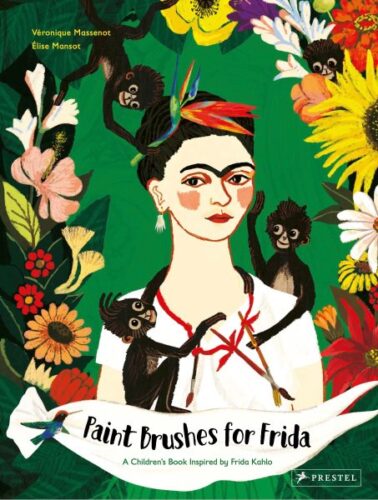
There are certain artists that have been ordained appropriate for children. I’d love to see a research study done on the process that takes place over the intervening decades that prompts one person or another to become popular as a children’s book subject. But I digress. Frida Kahlo, once more, stars in a book, but I found this one to be nicely playful. Rather than give you all the facts of her life, you get a clear sense of what some of her day-to-day struggles might have felt like. It begins with Frida in bed, in pain, and Diego’s gone out so he’s no help. She wants to paint but she can’t move. Mansot, does a great job of invoking, but not attempting to replicate, the art Frida wants to make, as she lies there thinking about it. And, best of all, it ends with a gorgeous rendering of Frida’s “Self-Portrait with Monkeys.” This is an ideal book if you want kids to get a sense or a taste of Frida, but don’t necessarily want to commit to a serious picture book biography quite yet.
Wild Summer: Life in the Heat by Sean Taylor and Alex Morss, ill. Cinyee Chiu
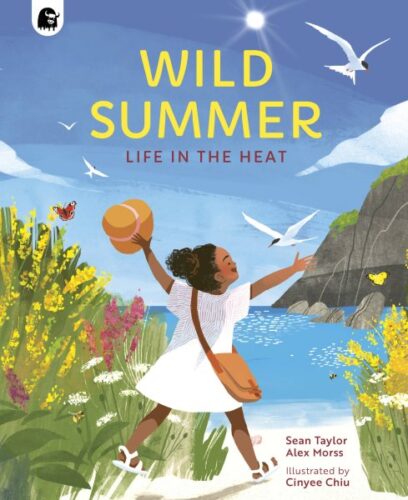
A girl and her grandfather explore the beauty and dangers of summertime together. A delightful trip into the wilds of the warmest season. I didn’t walk into this particular book with any expectations, but what I found was this nice, nuanced look at a girl and her grandfather exploring all the different aspects of summer, both good and bad, in terms of the natural world. Swimming and wildfires. Dragonflies and heat. It’s also an interesting case where the backmatter actually looks like it might be intended for kids rather than educators. Best of all, there’s a section specifically identified for kids called “How You Can Help”. I know we always like to see that. This is eco-fiction at its finest.
Want to see other lists? Stay tuned for the rest this month!
December 1 – Great Board Books
December 2 – Picture Book Readalouds
December 3 – Simple Picture Book Texts
December 4 – Transcendent Holiday Picture Books
December 5 – Rhyming Picture Books
December 6 – Funny Picture Books
December 7 – CaldeNotts
December 8 – Picture Book Reprints
December 9 – Math Books for Kids
December 10 – Gross Books
December 11 – Books with a Message
December 12 – Fabulous Photography
December 13 – Translated Picture Books
December 14 – Fairy Tales / Folktales / Religious Tales
December 15 – Wordless Picture Books
December 16 – Poetry Books
December 17 – Unconventional Children’s Books
December 18 – Easy Books & Early Chapter Books
December 19 – Comics & Graphic Novels
December 20 – Older Funny Books
December 21 – Science Fiction Books
December 22 – Fantasy Books
December 23 – Informational Fiction
December 24 – American History
December 25 – Science & Nature Books
December 26 – Unique Biographies
December 27 – Nonfiction Picture Books
December 28 – Nonfiction Books for Older Readers
December 29 – Best Audiobooks for Kids
December 30 – Middle Grade Novels
December 31 – Picture Books
Filed under: 31 Days 31 Lists, Best Books, Best Books of 2022
About Betsy Bird
Betsy Bird is currently the Collection Development Manager of the Evanston Public Library system and a former Materials Specialist for New York Public Library. She has served on Newbery, written for Horn Book, and has done other lovely little things that she'd love to tell you about but that she's sure you'd find more interesting to hear of in person. Her opinions are her own and do not reflect those of EPL, SLJ, or any of the other acronyms you might be able to name. Follow her on Twitter: @fuseeight.
ADVERTISEMENT
ADVERTISEMENT
SLJ Blog Network
The Moral Dilemma of THE MONSTER AT THE END OF THIS BOOK
K is in Trouble | Review
Parsing Religion in Public Schools
ADVERTISEMENT








It’s been a long wait for another book by Shirin Yim Bridges. Ruby’s Wish is one of my all-time favorites and is always a hit with kids.